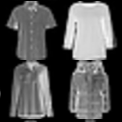The computational resources required to train a model have been increasing since the inception of deep networks. Training neural networks on massive datasets have become a challenging and time-consuming task. So, there arises a need to reduce the dataset without compromising the accuracy. In this paper, we present novel variations of an earlier approach called reduction through homogeneous clustering for reducing dataset size. The proposed methods are based on the idea of partitioning the dataset into homogeneous clusters and selecting images that contribute significantly to the accuracy. We propose two variations: Geometrical Homogeneous Clustering for Image Data Reduction (GHCIDR) and Merged-GHCIDR upon the baseline algorithm - Reduction through Homogeneous Clustering (RHC) to achieve better accuracy and training time. The intuition behind GHCIDR involves selecting data points by cluster weights and geometrical distribution of the training set. Merged-GHCIDR involves merging clusters having the same labels using complete linkage clustering. We used three deep learning models- Fully Connected Networks (FCN), VGG1, and VGG16. We experimented with the two variants on four datasets- MNIST, CIFAR10, Fashion-MNIST, and Tiny-Imagenet. Merged-GHCIDR with the same percentage reduction as RHC showed an increase of 2.8%, 8.9%, 7.6% and 3.5% accuracy on MNIST, Fashion-MNIST, CIFAR10, and Tiny-Imagenet, respectively.
翻译:自深层网络建立以来,培训模型所需的计算资源一直在增加。关于大规模数据集的培训神经网络已成为一项艰巨和耗时的任务。因此,有必要减少数据集,同时不损害准确性。在本文中,我们展示了一种更早期方法的新变异,即通过同质集群减少数据元件的大小;拟议方法基于将数据集分成同质集群和选择有助于极大提高准确性的图像的设想。我们提出了两种变异:图像数据减少的几何性同质聚合(GHCIDR)和基准算法的合并GHCIDR-通过同质集群(RHC)减少数据集的准确性,以提高准确性和培训时间。GHCIDR背后的直觉是按数据集的群集权重和几何分布选择数据点,以完全链接组合的方式将数据集合并为同一标签。我们用三种深学习模型-完全连通的网络(FCNNMIGI)、VGG1和VGG16。我们用四种变式对四种数据-9%的精确性数据采集-IMIS-IMIS、8-IMIS IMIS-百分数增加。




